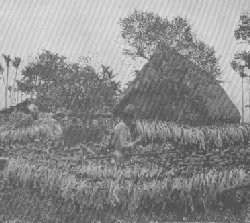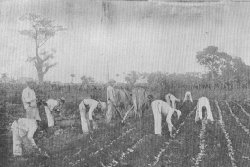|
In Connecticut is found a remarkable innovation in tobacco culture, consisting of a tent covering eight acres, devoted to this purpose. There are others in the same district, and under these broad canopies Sumatra leaf tobacco is grown, so much finer in quality than that raised in the open fields that it commands 68 cents per pound, while the latter brings but 25 cents. In 1892, Ariel Mitchelson, of Tariffville, Connecticut, inaugurated the idea of growing tobacco under cover. At a cost of $250 per acre he tented 18 acres of his best tobacco land with cheesecloth and produced a crop of Sumatra leaf far superior to any theretofore grown in the United States. First, posts, nine feet high, were put up, one rod apart, on spaces of tobacco land aggregating 18 acres. Over and between the posts stringers and lines of galvanized wire run, and then cheesecloth was spread and drawn taut over all. The tents were of unexampled hugeness, and were very strong, for they were fortified 196 posts to the acre, and with an abundance of snap hooks, rings and cloth. In the tents, Sumatra leaf tobacco, was planted, the rows being set out in the different tents at different times, in order that the several crops would ripen one after the other. As soon as the plants began to grow the advantages of the cheesecloth covering began to manifest themselves. First, there was the freedom from insects; all the evil from that source was quite destroyed. The soil kept soft. It did not harden nor cake.In a word, the tents united all the advantages of the open-air and of the hothouse. The plants had the hardy vigor of their out-door brothers, and at the same time they had the fineness that a hothouse's protection gives. By the time early summer had arrived they had reached so great a height that their leaves touched the nine-foot roof.
Meanwhile the tobacco was harvested. The first trial field of a third of an acre yielded 700 pounds, and sold for $473.70, an average of 68 cents a pound. This price compared well with the 25 cents a pound that was being paid at the time for leaf grown in the old way. And the tobacco itself compared well with the tobacco grown in the old way. It yielded 2,000 pounds to the acre—an unprecedented yield—and the leaves were of an unprecedented size, an unprecedented shape, and an unprecedented quality. Universally they were admitted to excel the leaves that are grown in Sumatra itself. Sumatra does with America a business in cigar wrappers that amounts annually to $6,000,000. In Connecticut and in Massachusetts, since a way has been found to excel the imported crop, they expect now to take from Sumatra all that business. That is why tents are going up all over the Connecticut and Massachusetts tobacco country—why green fields are coming to resemble great aggregations of colossal circuses.
The leaves of the tobacco plant naturally grow in three grades. Those nearest the roots are the strongest, since they have the first call upon the sap of the plant. Leaves half way up the stem are of medium strength, while the topmost are the mildest. About the beginning of September the crop is gathered. Sometimes leaves are gathered at intervals in order to obtain uniformity of quality. As a rule, the plant is cut down at once by severing the stem in the morning, and then is carefully laid on the ground and exposed to the heat of the sun during the day, the juicy, brittle leaves thus becoming wilted or placid, and bendable without breaking. Before evening, the leaves are carefully collected and stored in sheds. MONSTER SHIP CANALS |

